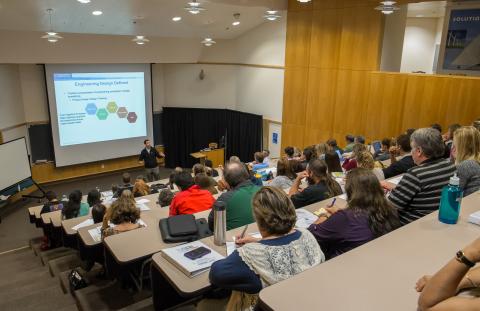When accessibility is placed at the forefront of learning, we can move beyond case-by-case accommodations and towards inclusive courses in which no student is excluded or disadvantaged. Consistently following best practices for creating accessible digital learning materials helps you account for the different needs of students and instructors under a range of potential circumstances. TAs and instructors should consult together about implementing specific accessibility practices for students with specific needs, and should also discuss any accessibility concerns the TA might have for themselves.
Creating accessibility in your classroom
Accessibility in teaching and learning refers to designing courses and assessments as well as developing teaching styles and strategies to meet the needs of students with a range of backgrounds, abilities and learning styles. UCSB encourages all students with disabilities who wish to receive reasonable accommodations to seek services through Disable Student Programs (DSP). Instructors will receive approved accommodation instructions from DSP directly. We encourage instructors to also implement equity-minded practices, Universal Design for Learning, and the following accessibility practices to help students with physical or learning disabilities, mental health challenges, and chronic illnesses as well as non-traditional students, first-generation students, students who are parents, athletes, or military service members.

Remember that not all students at UCSB fit common cultural assumptions of who is an undergraduate student. Language that insinuates college students are all young, single adults with school as their only major responsibility may displace non-traditional students such as those who are parents, military service members, older than 25 years old, transfer students, low-income, or have full-time careers. Consider how your linguistic choices can normalize certain experiences in your course while marginalizing others.
Teaching materials
It’s easy to make your teaching materials accessible when you cultivate the following habits in your documentation and teaching style. Many of the guidelines below are already common practices for UCSB instructors and TAs, and can become habits with just a bit of intentionality and effort. Many more details and information can be found on the Accessibility website of the UC Office of the President.
- Provide important information in written and oral form. For instance, if an announcement is made in class, also send students an email - and vice-versa.
-
Inform students when there is information on slides or in textbooks that they won’t be expected to remember or learn so they can prioritize what they write down or study.
-
Ensure that there are free or affordable ways for students to access the required course materials (e.g., books, softwares, etc.). For instance, you may place course reading materials on course reserves at the UCSB library.
-
For legibility of handouts and slides, use a sufficient color contrast between text color and background color (e.g., black background and white text). Additionally, use sans serif fonts and make them large enough for students in the whole room to view.
-
Include closed captioning on recorded lectures. Automated captioning for videos is available in GauchoCast with just a few clicks. If a student needs high-quality captioning as an accommodation through DSP, send a help request to help@id.ucsb.edu to get your videos professionally captioned. This applies to videos that you recorded yourself with the Panopto Recorder, videos you uploaded to GauchoCast from another source, and recorded Zoom sessions.
- Remind students that they can request services for note-taking from DSP.
1) Students with visual, motor, and learning disabilities (like dyslexia) use assistive technologies that help them read and navigate through digital texts and websites. An easy way to make sure your documents are accessible is to make a habit of using Heading Styles in Microsoft or Google and on your course website for titles, subtitles, table headers, and lists. Screen readers recognize the structure of the headings and will read the content in the correct order, and allow students to skip through the headings to find the information they need.
-
Use original digital text documents or properly OCR (optical character recognition) scanned documents, where possible. Contact the UCSB Library to get help doing OCR scanning.
-
Include alternative text when images appear on your documents, slides, or course website. Alternative text provides a description of what the image or graphic is and why it is relevant to the course content. Such information is useful for students with visual impairments as well as students who are unfamiliar with culturally specific images (e.g., celebrities, memes, monuments).
2) Remind students that DSP provides resources for transcription and diction as well as services for reading/e-text.
Class set-up
Make your policies and expectations both clear and as flexible as you can to accommodate students who have undisclosed disabilities or temporary illnesses and life circumstances. An easy way to do this is holding office hours at times and places that are convenient for students, including offering Zoom office hours and appointments for students who have other obligations during office hours.

- Have some flexibility with attendance and late homework. For instance, if attendance is mandatory, allow students to miss at least one day without penalty or explanation.
-
Consider policies that allow students to learn from their mistakes, like re-taking an exam or earning back some credit on assignments that they did poorly on.
-
Learn more about your students by administering a pre-course survey, and allow students to express anonymously whether any of the course policies or expectations may pose an issue for them. If students are permitted accommodations through DSP, avoid asking students to disclose the nature of any of their accommodations.
- Include statements of accommodation on your syllabi and GauchoSpace site.
Student participation in class activities are essential to building classroom community. While designing the lessons, assessments, and activities for your course, incorporate inclusive teaching principles and Universal Design for Learning.
-
Allow students to have preferential seating. Strict seating charts can pose an issue for different students for a range of reasons. For instance, some students prefer sitting towards the back of class if they need to leave a few minutes early without distracting their peers, and others may prefer to sit in the front to ensure they are not distracted.
-
Be mindful of students' abilities to participate fully in every classroom activity (e.g. activities that require students to walk around). Students come to class with a range of physical abilities, energy levels, and skills, so consider assigning 2-3 roles that students can choose from when doing activities. For example, some students can be the illustrators while others can be the presenters.
Give students options for assessments, where possible. That is, for summative assessments that don't need to be high-stakes exams, allow students to choose how to express their learning from a list of topics, prompts, or end-products. For example, allow students to write a paper, create a mini-documentary, or build a website.
- Encourage students to work with DSP to document any disability accommodations (e.g. extended time on exams).
- Learn more about the responsibilities of the student, DSP, the instructors, and department when it comes to providing exam accommodations for students with disabilities.